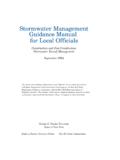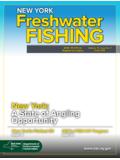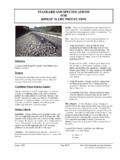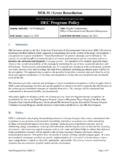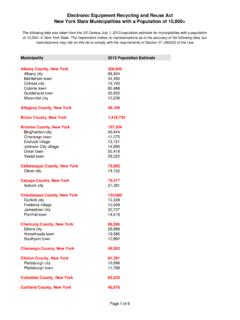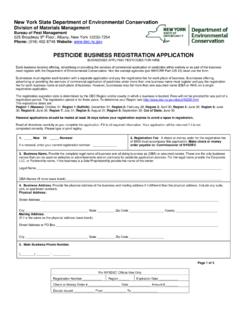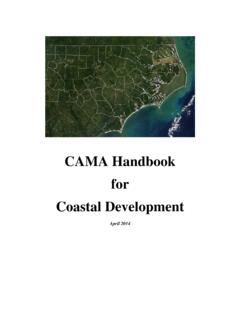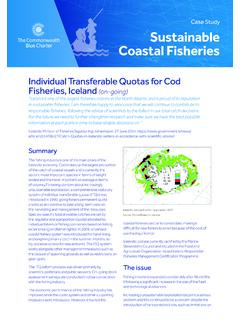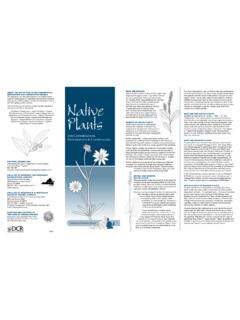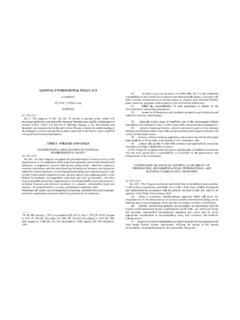Transcription of Chapter 5: Green Infrastructure Practices - New York State ...
1 New York State Stormwater management Design Manual Chapter 5: Green Infrastructure Practices Section Planning for Green Infrastructure : Preservation of Natural Features and Conservation Design Chapter 5: Green Infrastructure Practices This Chapter presents planning and design of Green Infrastructure Practices acceptable for runoff reduction. Green Infrastructure planning includes measures for preservation of natural features of the site and reduction of proposed impervious cover. The Green Infrastructure techniques include Practices that enable reductions in the calculated runoff from contributing areas and the required water quality volume. Section Planning for Green Infrastructure : Preservation of Natural Features and Conservation Design The first step in planning for stormwater management using Green Infrastructure is to avoid or minimize land disturbance by preserving natural areas. Development should be strategically located based on the location of resource areas and physical conditions at a site.
2 Also, in finalizing construction, soils must be restored to the original properties and according to the intended function of the proposed Practices . Preservation of natural features includes techniques to foster the identification and preservation of natural areas that can be used in the protection of water, habitat and vegetative resources. Conservation design includes laying out the elements of a development project in such a way that the site design takes advantage of a site's natural features, preserves the more sensitive areas and identifies any site constraints and opportunities to prevent or reduce negative effects of development. The techniques covered in this section are listed in Table Table Planning Practices for Preservation of Natural Features and Conservation Design Practice Description Preservation of Undisturbed Delineate and place into permanent conservation undisturbed forests, native Areas vegetated areas, riparian corridors, wetlands, and natural terrain.
3 Define, delineate and preserve naturally vegetated buffers along perennial Preservation of Buffers streams, rivers, shorelines and wetlands. Reduction of Clearing and Limit clearing and grading to the minimum amount needed for roads, Grading driveways, foundations, utilities and stormwater management facilities. Avoid sensitive resource areas such as floodplains, steep slopes, erodible Locating Development in soils, wetlands, mature forests and critical habitats by locating development Less Sensitive Areas to fit the terrain in areas that will create the least impact. Use clustering, conservation design or open space design to reduce Open Space Design impervious cover, preserve more open space and protect water resources. Restore the original properties and porosity of the soil by deep till and Soil Restoration amendment with compost to reduce the generation of runoff and enhance the runoff reduction performance of post construction Practices .
4 5-1. New York State Stormwater management Design Manual Chapter 5: Green Infrastructure Practices Section Planning for Green Infrastructure : Preservation of Natural Features and Conservation Design Preservation of Undisturbed Areas Description: Important natural features and areas such as undisturbed forested and native vegetated areas, natural terrain, riparian corridors, wetlands and other important site features should be delineated and placed into permanent conservation areas. Key Benefits Helps to preserve a site's natural hydrology and water balance Can act as a non-structural stormwater feature to promote additional filtration and infiltration Can help to preserve a site's natural character, habitat and aesthetic appeal Has been shown to increase property values for adjacent parcels Can reduce structural stormwater Figure Example of natural resource inventory plan (Source: management storage requirement Georgia Stormwater Manual, 2001).
5 And may be used in runoff reduction calculations (see section ). Typical Perceived Obstacles and Realities Preserved conservation areas may limit the development potential of a site With clustering and other development incentives, development yield can be maintained Preserved conservation areas may harbor nuisance wildlife, vegetation, and insects and may present safety hazards - Once Stream established, natural conservation areas must be protected during construction and managed after occupancy by a responsible party able to maintain the areas in a Wetland natural State in perpetuity; proper 5-2. New York State Stormwater management Design Manual Chapter 5: Green Infrastructure Practices Section Planning for Green Infrastructure : Preservation of Natural Features and Conservation Design management and maintenance will address nuisance and safety issues Using this Practice Delineate and define natural conservation areas before performing site layout and design Ensure that conservation areas and native vegetation are protected in an undisturbed State through the design, construction and occupancy stages Check with the municipality to determine if there are local laws and ordinances that regulate wetlands, stream buffers, forests or habitat protection Discussion Conservation of natural areas such as Figure Aerial photograph of development project illustrating preservation of undisturbed natural areas (Source: undisturbed forested and native-vegetated Arendt, 1996).
6 Areas, natural terrain, riparian corridors and wetlands on a development project can help to preserve pre-development hydrology of the site and aid in reducing stormwater runoff and pollutant load. Previously disturbed and/or managed forest areas may be considered for permanent conservation if they are judged to provide the benefits outlined in this section. Undisturbed vegetated areas also promote soil stabilization and provide for filtering and infiltration of runoff. Natural conservation areas are typically identified through a site-analysis stage using mapping and field- reconnaissance assessments. Areas proposed for protection should be delineated early in the planning stage, long before any site design, clearing or construction begins. When done before the concept-plan phase, the planned conservation areas can be used to guide the layout of a project. Figure shows components of a natural resources inventory map with proposed conservation areas delineated.
7 Preservation areas should then be incorporated into site-development plans and clearly marked on all construction and grading plans to ensure that construction activities are kept out of these areas and that native 5-3. New York State Stormwater management Design Manual Chapter 5: Green Infrastructure Practices Section Planning for Green Infrastructure : Preservation of Natural Features and Conservation Design vegetation is undisturbed. The boundaries of each conservation area should be mapped by carefully determining the limit which should not be crossed by construction activity. Once established, natural conservation areas must be protected during construction and managed after occupancy by a responsible party able to maintain the areas in a natural State in perpetuity. Typically, conservation areas are protected by legally enforceable deed restrictions, conservation easements or a maintenance agreement. When one or more of these measures is applied, a permanently protected natural area can be used to reduce the area required for treatment by structural stormwater management measures (see Figure for a representative project illustrating natural resource area protection).
8 Preservation of Buffers Description: Naturally vegetated buffers should be defined, delineated and preserved along perennial streams, rivers, shorelines and wetlands. Key Benefits Riparian buffers treat stormwater and improve water quality Can be used as nonstructural stormwater infiltration zones Can keep structures out of the floodplain and provide a right-of-way for large flood events Help to preserve riparian ecosystems and habitats Can serve as recreational areas May be used in runoff reduction calculations if the criteria in this section are met Typical Perceived Obstacles and Realities Buffers may result in a potential loss of developable land Regulatory tools or other incentives may be available to protect the interests of property owners Private landowners may be required to provide public access to privately held stream buffers . Effective buffers can be maintained in private ownership through deed restrictions and conservation easements Nuisance wildlife, vegetation, and insects will be present due to the natural buffer area Once established, vegetated buffers must be protected during construction and managed after occupancy 5-4.
9 New York State Stormwater management Design Manual Chapter 5: Green Infrastructure Practices Section Planning for Green Infrastructure : Preservation of Natural Features and Conservation Design by a responsible party able to maintain Figure Buffer around Rondout Creek, Accord, NY. the areas in a natural State in perpetuity;. proper management and maintenance will address nuisance issues Using this Practice Delineate and preserve naturally vegetated riparian buffers (as well as vegetated buffers along streams listed as intermittent by the Department). Define the width, identify the target vegetation, and designate methods to preserve the buffer indefinitely Ensure that buffers and native vegetation are protected throughout planning, design, construction and occupancy Consult local planning authority for local wetland and/or stream regulations or guidelines for more stringent minimum buffer width Discussion A riparian buffer is a special type of natural conservation area along a stream, wetland or shoreline where development is restricted or prohibited.
10 The primary function of buffers is to protect and physically separate a stream, lake, coastal shoreline or wetland from polluted stormwater discharges from future disturbance or encroachment. If properly designed, a buffer can provide stormwater management functions, can act as a right-of-way during floods, and can sustain the integrity of water- resource ecosystems and habitats. An example of a riparian stream buffer is shown in Figure 5-5. New York State Stormwater management Design Manual Chapter 5: Green Infrastructure Practices Section Planning for Green Infrastructure : Preservation of Natural Features and Conservation Design Forested riparian buffers should be maintained and managed and reforestation should be encouraged where no wooded buffer exists. Proper restoration should include all layers of the forest plant community, including understory, shrubs and groundcover, not just trees. A riparian buffer can be of fixed or variable width but should be continuous and not interrupted by impervious areas that would allow stormwater to concentrate and flow into the stream without first flowing through the buffer.
